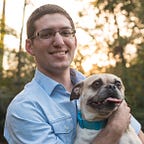A look back at The Road Ahead: starting-up a small business with GoodRoads
Reflecting on three years spent discovering, prototyping, marketing and bootstrapping a start-up determined to democratize pavement management
6 min readMay 5, 2020
The highlights
Problem worth solving
Most cities can’t afford to properly assess their roads as regularly as they should:
- No budget
- Not trained to inspect
- Not enough time
- Not sure how to analyze and act upon the data
What we progressively built
- A small device that records road quality data and captures images
- Artificial intelligence that we trained to inspect the road shown in each photo as per an industry standard
- A web-based application that enables access to, analysis of, and actions upon that data
- And a service model that makes all of this available to any-size city
The roles I played thus far
- Interviewer: to understand what we should build, I had to understand what our target users and customers didn’t have today that would help them be as good at their jobs as our Co-Founder envisioned.
- Prototyper: early interviews offered us an opportunity to demo our ideas for the purpose of eliciting real-time feedback from potential customers: Pavement Managers and their teams.
- Full-stack Developer: as soon as we had some data and ideas for displaying it, we started building a web application. We continually re-evaluated the proper technologies and extended the capabilities of our app based on user feedback and new data we were generating.
- Marketer: Presentations, product demos, pop-up banners and highlight reels for local pitching events, conferences and closed-door meetings
- Sales Manager: Drafting proposals for pilot projects and annual contracts, and attending sales meetings where we hoped to close deals
- Sounding Board: The Founder and I speak routinely about the direction of the business, our products, our team, and how we must adapt to our market’s traditionally conservative sales process
- Challenger: The Founder and I have a strong enough relationship such that we can each feel comfortable debating one another’s intentions. Our conversations have helped both of us make more informed decisions.
Videos made along the way
In April, 2017, I re-connected with an old pal for lunch.
He was about to quit his job and start a business, and wanted help.
I accepted, sparing any financial reimbursement, because I knew that the opportunity would pay me back in several other ways.
Three years later, we are a team of nearly 10.
We’re selling the products and services that I believe will leapfrog our competitors.
And we are on a mission: to help cities of any size leverage technology they could never previously afford to make more informed decisions about maintaining their roads.
Milestones and other notable events as told through newsletter photos
Early sketches, wireframes and prototypes
Screens from the current web application
A revamped website catering to potential investors
I accepted this job without expecting to get paid.
But I’ve been paid back in all the right ways:
- Better listener
- Better communicator
- Better salesperson
- Better software developer
- Better interviewer
- Better business sense
- Better marketer
- Better teammate
Better at getting more value from a ‘no’ answer, and probing a counterfeit ‘yes’ answer until the true ‘no’ is revealed.
Hopefully the next three years will bear the fruits of our labor.
If not, it’s been a highly rewarding experience.
Thank you for reading!
